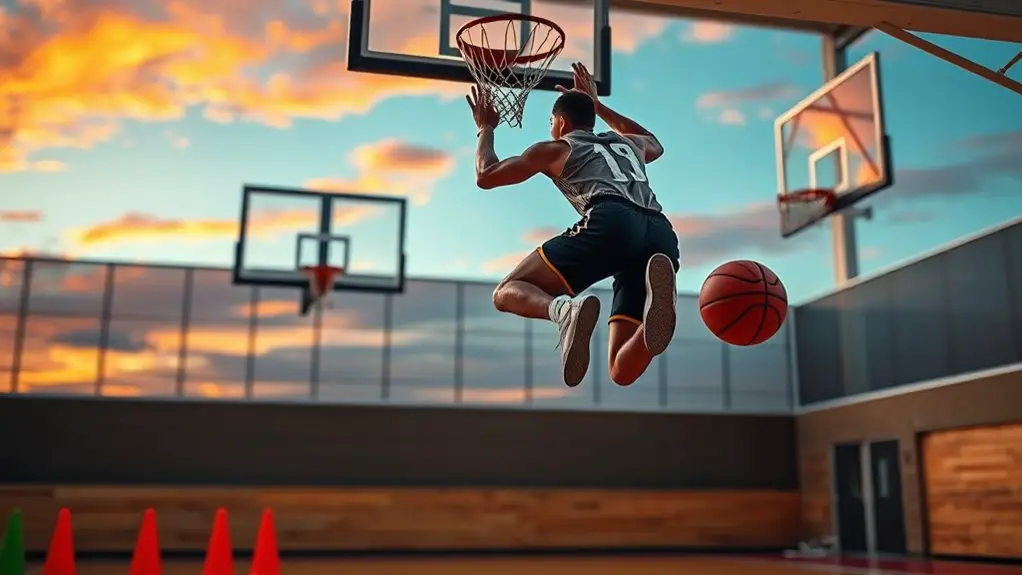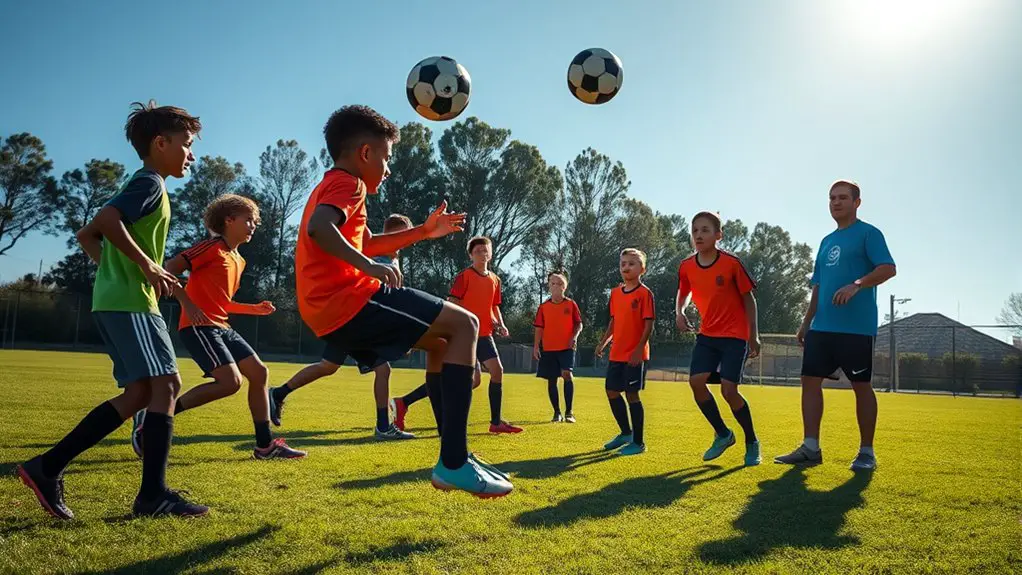To increase your dunking ability, focus on plyometric drills like box jumps, depth jumps, and tuck jumps. These exercises build explosive power and improve your jumping mechanics. Single-leg hops help with balance, while medicine ball throws boost upper body strength essential for dunking. Adding plyometric push-ups can enhance your overall athleticism. Incorporate these drills into a training routine, and you'll skyrocket your performance. Keep exploring to access more training insights that can elevate your game!
Understanding Plyometrics and Their Benefits for Dunking
When you think about improving your dunking ability, understanding plyometrics is essential. Plyometric physiology focuses on how your muscles react during explosive movements, like jumping. By training your body to harness this power, you can elevate your jump mechanics and reach new heights.
Plyometrics involve quick, powerful bursts of movement that enhance your fast-twitch muscle fibers. These fibers are vital for generating the force needed to propel yourself upward. You'll not only build strength but also improve your coordination and agility, giving you that freedom to soar. Incorporating the stretch-shortening cycle into your routine can help you develop the explosive strength necessary for dunking. Whether it's through bounding exercises or jump squats, each movement primes your body for greater vertical leaps. Embrace the challenge, and you'll soon find yourself gliding toward that rim with newfound confidence and skill.
Box Jumps: Power and Precision
Box jumps are a fantastic way to build both power and precision in your vertical leap. You'll want to focus on jump technique fundamentals to maximize your performance while also exploring progression and variations to keep things challenging. Remember, safety and injury prevention should always be a priority as you push your limits. Additionally, incorporating plyometric exercises into your routine can significantly enhance your overall explosiveness and athletic performance.
Jump Technique Fundamentals
To master jump technique fundamentals, focusing on box jumps can greatly enhance your power and precision. These drills help refine your jumping mechanics, allowing you to execute a more effective vertical leap. Start by positioning yourself correctly—feet shoulder-width apart, knees slightly bent. As you prepare to jump, engage your core and explode upward, driving your knees toward your chest. Land softly on the box, absorbing the impact through your legs. This not only builds strength but also improves your body control. By practicing box jumps regularly, you'll develop the essential skills needed for higher jumps and better overall performance. Remember, every solid jump starts with a strong foundation in technique, so embrace the process and let your freedom to soar shine through!
Progression and Variations
Building on your foundational jump technique, incorporating progression and variations into your box jump routine can greatly enhance your power and precision. To achieve this, embrace progressive overload by gradually increasing the height of the box or adding weights. This'll push your limits and develop explosive strength.
Additionally, use variation strategies like single-leg box jumps or lateral jumps to challenge your body in different ways. These variations not only keep your workouts exciting but also target different muscle groups, enhancing your overall athletic performance. Remember, the key is to remain adaptable and creative in your training. By diversifying your approach, you'll reveal new levels of power and precision, bringing you closer to that dunk you've been dreaming of.
Safety and Injury Prevention
While pushing your limits with box jumps, safety and injury prevention should always be top priorities. To protect yourself and release your full potential, begin with adequate warm-up exercises. These help prepare your muscles and joints, reducing the risk of strains or sprains. Focus on dynamic movements like leg swings and lunges to get your body primed.
When jumping, maintain proper form—keep your knees aligned with your toes and land softly to absorb impact. Choose a box height that challenges you but doesn't compromise your safety. Always listen to your body; if something feels off, take a step back. By prioritizing safety and incorporating injury prevention techniques, you can enjoy the freedom of explosive power while minimizing risks.
Depth Jumps: Enhancing Reactive Strength
When it comes to depth jumps, mastering your technique is essential for maximizing your performance. These explosive drills can greatly boost your reactive strength, making it easier to elevate your jumps. Additionally, depth jumps are a form of plyometric training that enhances explosiveness by developing maximum force in short intervals. Let's explore how to execute depth jumps effectively and the benefits they offer for your dunking ability.
Technique for Depth Jumps
To effectively enhance your reactive strength through depth jumps, mastering the technique is essential. Start by standing on a sturdy box or platform. Step off rather than jumping, allowing gravity to pull you down. As you land, aim to absorb the impact with your knees slightly bent and your body upright. This depth jump technique focuses on minimizing ground contact time, so explode upward immediately after landing. Experiment with depth jump variations, like adding a lateral movement or a single-leg landing, to challenge your stability and strength. Remember, consistency is key—practice regularly to refine your form and boost your performance. Embrace the freedom of movement, and soon you'll feel the power in your jumps!
Benefits for Jumping Performance
Mastering depth jumps not only improves your technique but also greatly enhances your jumping performance. This dynamic exercise boosts muscle recruitment, allowing your body to engage more muscle fibers for powerful jumps. When you practice depth jumps, you're training your muscles to react quickly, which is essential for explosive strength. You'll find that as your reactive strength improves, your ability to spring off the ground will feel effortless. This freedom in movement translates directly to higher jumps and increased dunking ability. Plus, the mental aspect of depth jumps builds confidence, making you feel unstoppable on the court. So, embrace depth jumps and watch your jumping prowess soar as you reveal your true potential!
Broad Jumps: Building Horizontal Explosiveness
While many athletes focus on vertical jumps to boost their dunking ability, broad jumps are equally essential for developing horizontal explosiveness. Enhancing your horizontal power not only improves your overall athleticism but also translates into better performance on the court. Here are three broad jump techniques to help you release your potential:
- Start Position: Stand with your feet shoulder-width apart, knees slightly bent, and arms back.
- Explosive Jump: Swing your arms forward while pushing off the ground with your legs, aiming to land as far as possible.
- Landing Mechanics: Focus on landing softly with your knees slightly bent to absorb the impact and maintain balance.
Incorporating these broad jump techniques into your training will build strength and agility, allowing you to soar higher and dunk with confidence. Additionally, these exercises will enhance your leg power and overall explosive capabilities, essential for maximizing athletic performance. Embrace these drills, and watch your game elevate!
Tuck Jumps: Improving Core Stability and Power
Tuck jumps are a powerful way to enhance your core stability and explosive strength, which are essential for improving your dunking ability. By performing tuck jumps, you'll not only engage your entire lower body but also challenge your core strength, helping you develop the stability needed during your jump. The tuck jump benefits include increased power output, which translates to higher jumps and better control in the air.
To perform a tuck jump, start by standing with your feet shoulder-width apart. Explode upward, bringing your knees toward your chest while keeping your core tight. Land softly and immediately go into the next jump. This continuous movement builds endurance and maximizes your explosive power. A strong core acts as the foundation for powerful movements, allowing you to achieve greater heights in your dunk.
Incorporating tuck jumps into your routine will free you from limits, paving the way for impressive dunks. Remember, the stronger your core, the higher you'll fly, so commit to mastering this drill for best results.
Single-Leg Hops: Strengthening Balance and Coordination
Single-leg hops are an excellent way to enhance your balance and coordination, both essential for achieving a powerful dunk. By focusing on these aspects, you'll not only improve your vertical leap but also gain the freedom to maneuver better on the court. Here are three key benefits of incorporating single-leg hops into your training:
- Balance Enhancement: Engaging one leg at a time helps develop stability, making you more agile during gameplay.
- Coordination Drills: These hops force you to engage your core and other muscle groups, creating a more dynamic movement pattern.
- Injury Prevention: Strengthening each leg individually reduces the risk of imbalances and injuries, keeping you on the court longer. Additionally, balance training through exercises like single-leg hops can significantly improve your overall athletic performance.
Start adding single-leg hops to your routine, and watch how they elevate your performance! You'll feel more confident and in control as you approach the rim, ready to dunk with ease.
Medicine Ball Throws: Generating Upper Body Power
To elevate your dunking ability, incorporating medicine ball throws into your training can greatly boost your upper body power. These explosive movements are perfect for developing the strength needed to propel yourself off the ground. By launching a medicine ball, you engage your chest, shoulders, and arms, enhancing your upper body strength and coordination.
Start with basic throws, like the chest pass, before progressing to overhead slams. Focus on generating explosive strength throughout the movement. As you become more comfortable, increase the weight of the medicine ball to challenge yourself further. Incorporating upper body power exercises, such as bench press, can also complement your medicine ball training and lead to improved dunking performance.
Incorporating these throws into your routine not only improves your throwing mechanics but also translates to better dunking performance. You'll notice increased upper body power, which is essential for elevating your jump. So grab a medicine ball and start throwing—your dunking game will thank you!
Plyometric Push-Ups: Boosting Overall Athleticism
Release your athletic potential with plyometric push-ups, a dynamic exercise that not only builds upper body strength but also enhances overall explosiveness. By incorporating this powerful movement into your routine, you'll experience significant plyometric benefits that can elevate your athletic performance.
Here are three key advantages of plyometric push-ups:
- Increased Power: The explosive nature of this exercise trains your muscles to generate force quickly, essential for sports and activities that require speed.
- Improved Stability: Engaging your core while pushing off the ground helps enhance your balance and stability, critical for any athletic endeavor.
- Enhanced Endurance: Regular practice boosts muscular endurance, allowing you to maintain high energy levels throughout your game or workout.
Incorporating plyometric exercises into your training can further amplify your explosiveness and athletic capabilities. Embrace plyometric push-ups, and watch your overall athleticism soar, giving you the freedom to dominate on the court.
Creating a Plyometric Training Routine for Optimal Results
Building on the explosive power gained from plyometric push-ups, creating a structured plyometric training routine is crucial for maximizing your dunking ability. Start by determining your training frequency; aim for two to three sessions per week. This allows your muscles to recover while still pushing your limits.
Next, focus on exercise selection. Incorporate a mix of drills like box jumps, depth jumps, and plyometric lunges. These movements will target different muscle groups, enhancing your overall explosiveness. Be mindful of your form—quality trumps quantity. You want to guarantee that each rep is executed perfectly to prevent injuries and gain the most benefit. Additionally, incorporating calf raises into your routine will further strengthen your legs and improve jumping ability.
Lastly, listen to your body. If you're feeling fatigued, don't hesitate to adjust your routine. Freedom in your training will help you stay motivated and engaged. Embrace the process, and soon you'll notice significant improvements in your dunking ability!
Frequently Asked Questions
How Often Should I Perform Plyometric Drills Each Week?
To boost your performance, you should aim for a frequency of 2 to 3 times a week for plyometric drills. This allows your muscles to recover while still pushing your limits. Tailor your training schedule to fit your lifestyle, ensuring you've got enough recovery time. Remember, it's not just about intensity; it's about consistency and listening to your body. Find that balance, and you'll see great results without feeling burnt out.
Can Beginners Safely Perform Plyometric Exercises?
You might think plyometric exercises are too intense for beginners, but that's not entirely true. With the right approach, you can safely perform them. Focus on beginner safety by starting with low-impact variations and gradually increasing intensity. Exercise modifications, like using lower jumps or slower movements, can help you build strength and confidence without risking injury. Embrace the challenge, but listen to your body, and you'll enjoy the freedom of progress in your fitness journey.
What Equipment Is Necessary for Plyometric Training?
For effective plyometric training, you don't need much equipment. A sturdy pair of athletic shoes is essential for support and grip. You might also want a jump box or platform to practice jumping techniques safely. Resistance bands can add intensity to your workouts, enhancing training intensity. If you're feeling adventurous, a medicine ball can help with explosive movements. Keeping it simple lets you focus on your freedom to jump higher and stronger!
Are There Any Risks Associated With Plyometric Exercises?
Yes, there are risks associated with plyometric exercises, especially if you don't prioritize injury prevention. If you're not using proper form, you can strain muscles or joints. To enjoy the freedom of movement, it's essential to warm up properly, start with easier drills, and gradually increase intensity. Listen to your body and don't push through pain. With the right approach, you can minimize risks and maximize your gains in strength and agility.
How Long Until I See Results From Plyometric Training?
When you start plyometric training, your progress timeline can vary widely. It often depends on individual factors like your current fitness level, consistency, and how well you recover. While some people notice improvements in just a few weeks, others might take longer. The key is to stay patient and focused on your goals. Embrace the journey, and you'll eventually see the results you're aiming for with dedication and hard work.




